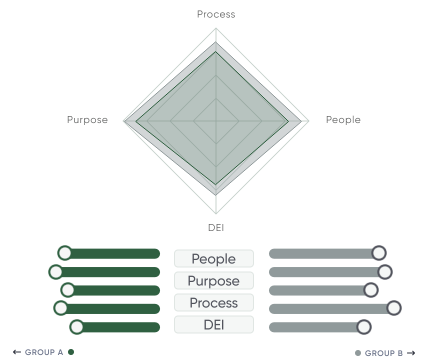5 Biggest Mistakes Companies Make on Culture Surveys (And How to Avoid Them)

Related Insights
Spoiler Alert: The 5 biggest mistakes companies make when running an organizational culture survey have absolutely nothing to do with the survey itself.
Shocking, right? After nearly a decade of helping organizations measure and transform their cultures, we've discovered that successful culture surveys aren't about perfectly crafted questions or sophisticated analytics platforms. The make-or-break factors happen before anyone clicks "submit" and long after collecting the data.
Think about the last culture survey you experienced. Was it transformative? Or did it feel like a corporate ritual with little impact? If you're nodding toward the latter, you're not alone.
In our work with Fortune 500 companies, fast-growing startups, and everything in between, we've seen how even the most well-intentioned culture initiatives can fall flat. The good news? The pitfalls are predictable and entirely avoidable.
Let's dive into the five critical mistakes that derail culture surveys and how you can ensure your next organizational culture assessment drives meaningful change.
Mistake #1: Underestimating the Power of Your Leaders
The single most influential factor in culture survey success isn't the perfect questionnaire or an enticing incentive—it's your leaders.
Let's put this into perspective: In our work as leadership consultants, we see organizations with strong leader buy-in get an average 20% higher response rate compared to those where leadership is merely informed. No amount of gift cards, pizza parties, or calendar reminders can match the impact of an engaged leader who genuinely believes in the process.
When we say "leaders," we're not referring to your C-Suite executives or VPs. We're talking about anyone with a span of care—team supervisors, project managers, shift leads—anyone who directly influences another person's work experience. Your frontline leaders often have the greatest access to the voices you most need to hear from.
The timing of leader involvement is as critical as which leaders you involve. If you bring them in when the survey goes live, you're already too late. Your leaders should know about the upcoming survey before anyone else does. At Chapman & Co., we implement a leader kick-off meeting where we walk through:
- The WHY behind the survey—connecting it directly to business outcomes
- The process and timeline for implementation
- Specific expectations for their involvement
- The consistent messaging they'll need to communicate
This approach leverages what behavioral scientists call the IKEA effect—people value what they help build. When leaders shape the survey process, they develop a sense of ownership that transforms them from passive participants to active advocates.
Consider the difference between a department head who merely forwards an HR email and one who tells their team, "I just completed our culture survey this morning—it took about 12 minutes. I genuinely look forward to hearing everyone's thoughts so we can improve together."
A survey is an act of engagement in and of itself. How you behave and communicate throughout the process matters just as much as the actions you take thereafter.
All culture is local. The leader of your team is most likely to influence your daily experience. This becomes a critical miss when those same leaders you skipped early in the process become unwilling participants in the action planning phase. In contrast, leaders involved from the start are already invested in the outcomes, making them more likely to follow through when it comes time to transform insights into action.
Mistake #2: Missing Crucial Communication Touchpoints in Your Survey Timeline
Here's a fundamental truth about human psychology: In the absence of information, people fill the void with their own narratives, and these rarely trend positively.
The weeks between survey completion and results sharing create a critical vulnerability in your culture survey process. If not handled appropriately, this can damage employee perceptions of the initiative. Without regular communication or real-time updates, your well-intentioned employee engagement survey can unintentionally breed cynicism and distrust.
Leaders often make the mistake of waiting until they have complete, polished results before communicating anything. By the time you're ready with those perfectly packaged insights and metrics, negative perceptions may have already taken root:
- "They're hiding something..."
- "The results must have been terrible..."
- "I knew nothing would happen when I filled this out..."
The solution is surprisingly simple yet remarkably effective: communicate even when there isn't substantive news or milestones to share. We call this the "No Update Update." It's a game-changer for maintaining trust and momentum.
Here's what an effective communication timeline looks like:
- Immediate Acknowledgment (Within 24-48 hours of survey close)
Check in with your organization by sending a sincere thank-you note to all participants, sharing the survey response rate, and expressing appreciation for their candor. - Process Transparency (1 week after survey close)
Share details about the analysis process and expected timeline—even if it seems mundane.
For example, with one of our clients, we were producing 110 individual reports and preparing for 27 departmental debriefs. Instead of radio silence during this analysis phase, we communicated these specifics:
"We're currently analyzing the feedback from over 7,000 team members. This involves producing 110 different reports across the organization. Throughout April, we'll be conducting 27 results conversations with various divisions. You can expect communication about your department's results by the end of April."
When you catch yourself thinking, "They don't really need to know this," that's precisely the information you should be communicating. This approach signals respect for your team members' investment in the process and acknowledges that their time and honest feedback are valued.
Mistake #3: Treating Survey Results as Data Points Instead of Human Experiences
Truly data-driven organizations are, at their core, human-driven organizations.
Too often, companies approach culture surveys as a mechanical exercise—a status check on the human machinery that powers their operation. They're conducted to satisfy board requirements, to advertise engagement efforts to the market, or to tick a box on the annual corporate initiatives list.
When your team members take time to provide feedback, they're not just respondents submitting data points—they're humans sharing their lived experiences. That spreadsheet with colorful graphs represents thousands of moments that make up your employees' work lives:
- The team leader who took the time to recognize someone's extra effort
- The frustrating process that adds two hours to everyone's workday
- The colleague who consistently makes others feel included
- The outdated policy that undermines your company's values in practice
Team members don't participate in surveys because they care about moving your employee Net Promoter Score from 63 to 67. They participate because they believe it might improve their daily work experience.
So, how do we bridge this gap? By approaching your organizational culture survey as a tool for empathetic understanding:
Highlight stories, not just statistics
When sharing survey results, include anonymous quotes and examples from open-ended questions that bring the numbers to life.
Connect improvements directly to employee feedback
When implementing changes, explicitly tie them back to specific survey insights: "You told us X was a challenge, so we're implementing Y to address it."
Decentralize the action planning
Culture happens at the team level. Equip your leaders to address the specific experiences of their teams rather than just implementing one-size-fits-all corporate initiatives.
Consider this perspective: Your team members spend around 40 hours a week in your organization. For many, that's more time than they spend with family and loved ones. That's not just a data point—it's a profound responsibility to ensure the time they spend with you is valuable for all parties.
Mistake #4: Letting Your Results Expire (Or Rushing to Replace Them)
When it comes to employee engagement surveys, many companies find themselves caught in a frustrating cycle—either letting valuable insights fade away unused or rushing into the next survey before acting on the previous one.
We see this mistake come in two equally problematic forms.
The Perpetual Survey Cycle
Sound familiar? Your organization runs on a rigid annual employee engagement survey schedule that looks something like this:
- January: Begin survey prep
- February: Communicate the upcoming survey
- March: Launch the survey
- April: Analyze and communicate survey results
- May: Discuss potential actions
- June: Form implementation teams
- July-December: Attempt to make meaningful change before starting the whole process again
This relentless cycle creates what we call "survey fatigue"—not just for the team members constantly asked for feedback, but also for the leaders expected to create meaningful change within increasingly compressed timeframes.
Leaders feel like they're facing an impossible challenge where they can never get ahead, while team members wonder why you keep asking what they think when little seems to change between surveys.
The False Expiration Date
The companion problem is the misconception that survey data has a short shelf life—that after a few months, it is somehow "expired" and no longer relevant.
This simply isn't true.
Your culture survey results remain relevant as long as you continue to reference, act upon, and communicate about them. As we like to say: "The more fuel you put on the survey fire, the longer it will burn."
Between open-ended, Likert, and multiple-choice questions, most comprehensive culture surveys include 50+ survey questions—far more areas than any organization could meaningfully address in six months. Yet many companies feel pressured to launch another survey before they tackle even a quarter of the insights from the previous one.
Breaking the Cycle
The solution isn't running surveys more frequently—it's communicating about them more effectively over a longer period.
Here's how to extend the life and impact of your survey results:
- Prioritize strategically, not comprehensively
Rather than trying to address every data point, identify the 2-3 key areas that will make the greatest difference to your company culture and employee experience. - Create a phased approach
Map out waves of initiatives over 12-18 months rather than trying to cram everything into a six-month window before the next survey. - Keep the conversation alive
Regularly reference survey findings in company communications, team meetings, and decision-making processes. - Connect new initiatives to past feedback
The phrase you should be repeating consistently is: "We heard you in the survey. You asked for X, so we're implementing Y." - Use pulse surveys strategically
Instead of repeating the comprehensive survey, use targeted pulse surveys at regular intervals to track progress on specific initiatives you've implemented.
Your culture survey results are only as valuable as the actions you take and—equally important—the connections you make between those actions and the employee feedback you received.
By breaking free from the artificial constraints of an annual survey cycle and instead creating a thoughtful, phased approach to implementing change, you can extract maximum value from each survey while building trust that feedback genuinely leads to improvement.
Remember, the goal isn't to survey more often—it's to make each survey more meaningful to your business and team.
Mistake #5: Not Leveraging a Third-Party for Your Survey
This isn't the "gotcha" moment where I reveal we've been secretly selling you something this whole time (though if you're curious about our Organizational Culture Survey, I won't stop you from checking it out).
This final mistake concerns a more fundamental issue: psychological safety and data integrity.
Your culture survey is essentially worthless without honest, unfiltered responses. When team members don't feel safe being candid, they either provide overly positive feedback, skip the survey entirely, or give neutral responses that don't provide actionable insights.
Many companies attempt to administer surveys internally, promising anonymity while collecting responses through company email addresses or internal systems. This creates what we call the "anonymity paradox"—you say responses are anonymous, but everything about the process signals the opposite.
Even with the best intentions, when surveys are administered in-house, team members often wonder,
- "Can my manager see my individual responses?"
- "Will my feedback affect my performance evaluation?"
- "Is my job at risk if I'm too honest?"
These concerns significantly compromise the integrity of your data.
A third-party provider offers several critical benefits:
- True Anonymity
Responses can't be traced back to individuals by anyone within your organization. - Reduced Risk of Internal Bias
Neutral parties analyze your organization's dynamics without preconceived notions. - Benchmark Capabilities
Compare your survey results against industry standards for more meaningful context. - Enhanced Credibility with Your Team
The simple act of investing in an external provider signals your commitment to an objective process and can improve participation rates.
When team members see that their anonymous feedback led to positive changes without negative repercussions, they become more willing to provide honest input in the future. This creates a virtuous cycle in which psychological safety increases and communication becomes more transparent throughout the organization.
The Bottom Line: Making Culture Surveys Count
Your organizational culture survey is more than a measurement tool—it's a powerful opportunity to demonstrate your commitment to creating a thriving work environment.
The most common mistakes have nothing to do with survey design or whether or not you’re asking the right questions and everything to do with how you approach the human elements surrounding it: leadership involvement, transparent communication, empathetic understanding, strategic implementation, and psychological safety.
By avoiding these five critical mistakes, you transform your culture survey from a perfunctory exercise into a catalyst for genuine organizational growth and continuous improvement. Remember that your culture isn't static, and employee engagement is up for grabs in today's job market.
When implemented strategically, organizational culture surveys can empower HR leaders with a data-driven approach to align employee engagement with the business outcomes your organization is trying to achieve. Ongoing culture assessment and improvement will equip leaders to be better positioned to implement change, improve employee engagement, and unify your growing business.
HR leaders—the ball is in your court. Don't let your people be the one area where your business makes uninformed decisions. Leverage their perspectives as a catalyst for success by strategically implementing a culture survey that avoids these common pitfalls.
Looking for support in developing an effective organizational culture survey strategy? At Chapman & Co. Leadership Institute, we specialize in helping organizations design and implement culture initiatives that drive meaningful change. Learn more about our approach to creating thriving workplace cultures.







